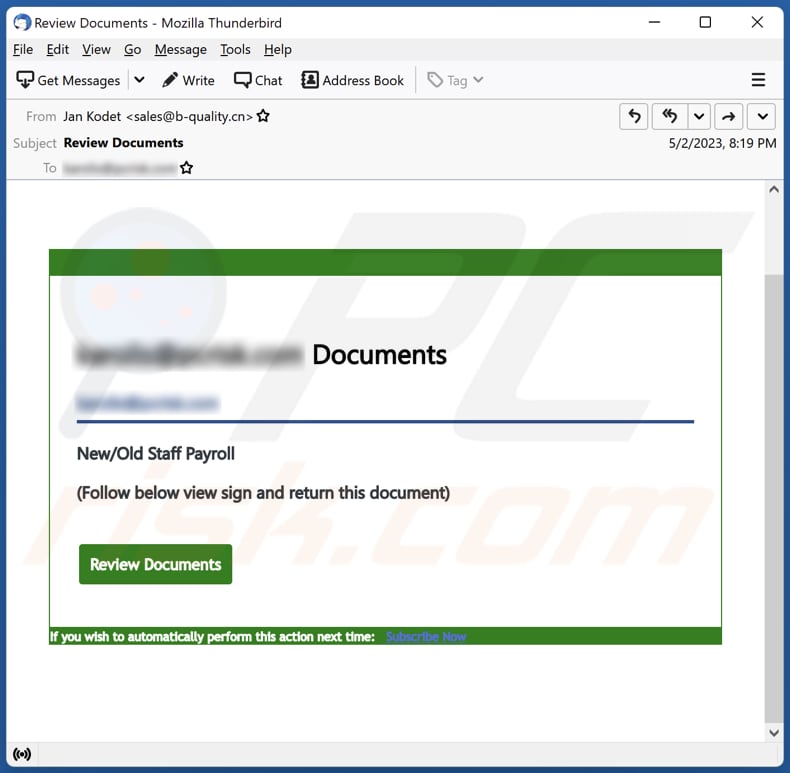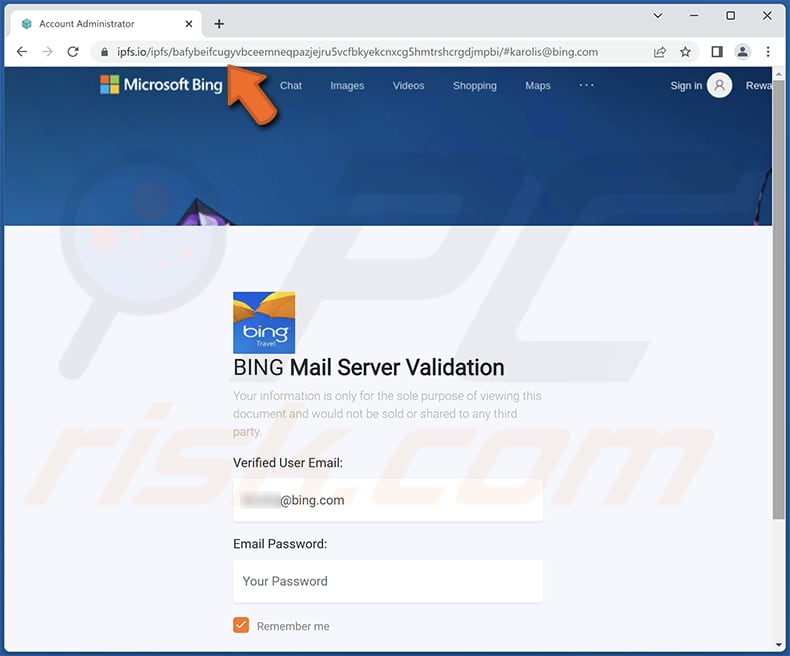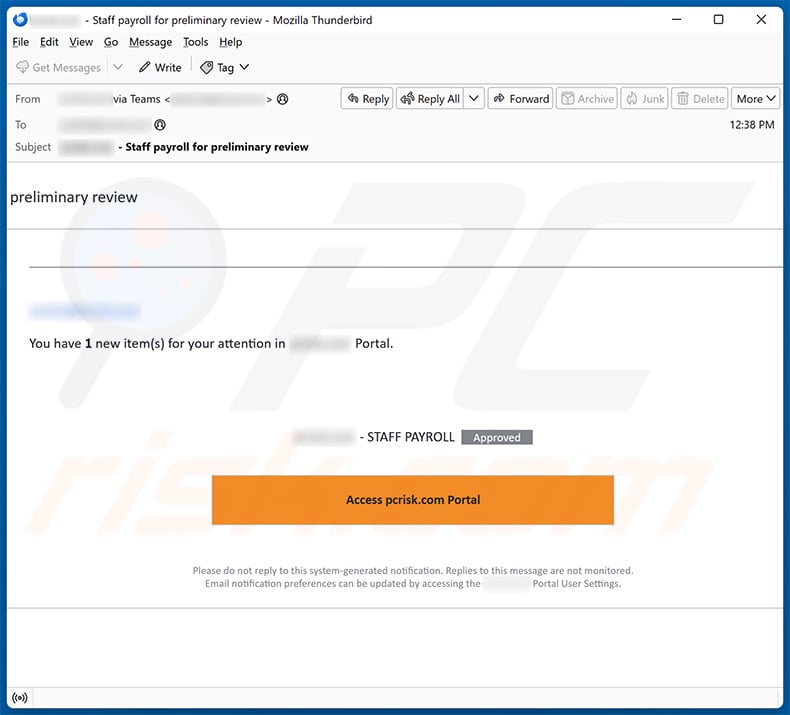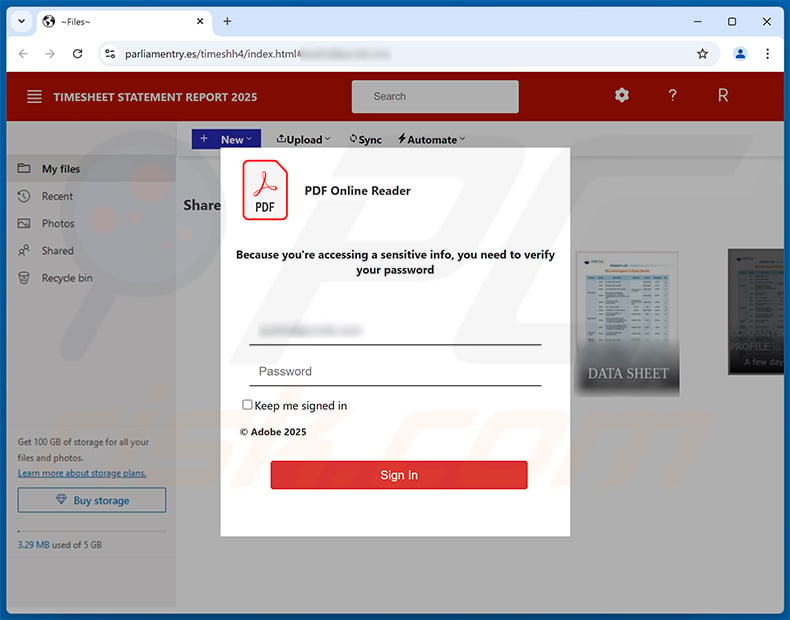How to spot scam emails like "New/Old Staff Payroll"
Phishing/ScamAlso Known As: New/Old Staff Payroll phishing email
Get free scan and check if your device is infected.
Remove it nowTo use full-featured product, you have to purchase a license for Combo Cleaner. Seven days free trial available. Combo Cleaner is owned and operated by RCS LT, the parent company of PCRisk.com.
What kind of scam is "New/Old Staff Payroll"?
Upon analyzing the email, our team has determined that its purpose is to trick recipients into revealing their personal information. Such letters are called phishing emails. The email in question urges recipients to review certain documents, but in reality, it is a fraudulent message that should be disregarded.

More about the "New/Old Staff Payroll" scam email
This phishing email attempts to trick recipients into believing that some important documents require their attention. The email uses urgent language and includes a link to "review documents". However, the link takes recipients to a fake website where they are asked to enter their login credentials, which scammers can use for fraudulent activities.
The phishing page in this email is designed to mimic the appearance of a legitimate email service provider based on the recipient's email address. For example, if the recipient uses Bing, the phishing page impersonates the legitimate Bing login page. The purpose of this page is to steal email account login credentials.
Depending on their intention, scammers can do various things with stolen email account login credentials. Some scammers use the stolen email account to send phishing emails to contacts on the victim's contact list, attempting to steal their personal information or login credentials.
Others use it to gain access to sensitive information in the victim's emails, such as financial information, personal information, or intellectual property. They may also use the email account to send spam messages or conduct other fraudulent activities.
In some cases, scammers may sell stolen email account login credentials on the dark web, where other cybercriminals can purchase them for various illegal activities.
| Name | New/Old Staff Payroll Email Scam |
| Threat Type | Phishing, Scam, Social Engineering, Fraud |
| Fake Claim | Recipients should review the provided documents |
| Disguise | Letter from an unnamed comany |
| Symptoms | Unauthorized online purchases, changed online account passwords, identity theft, illegal access of the computer. |
| Distribution methods | Deceptive emails, rogue online pop-up ads, search engine poisoning techniques, misspelled domains. |
| Damage | Loss of sensitive private information, monetary loss, identity theft. |
| Malware Removal (Windows) |
To eliminate possible malware infections, scan your computer with legitimate antivirus software. Our security researchers recommend using Combo Cleaner. Download Combo CleanerTo use full-featured product, you have to purchase a license for Combo Cleaner. 7 days free trial available. Combo Cleaner is owned and operated by RCS LT, the parent company of PCRisk.com. |
Similar scam emails in general
The common characteristic of such emails is that they aim to create a sense of urgency or fear in the recipient to prompt them to take immediate action without thinking or verifying the legitimacy of the email. They often use urgent or threatening language, offer something too good to be true, ask for personal or financial information, or contain a suspicious attachment or link.
These emails may also impersonate a trusted individual or organization to gain the recipient's trust. Examples of similar emails are "Email Access Is Set To Expire Email Scam", "Improvements To All Our e Mail Servers Scam", and "Your Account Expiry Email Scam". It is important to mention that interacting with such emails can lead to computer infections.
How do spam campaigns infect computers?
Malware can infiltrate users' computers through emails with malicious attachments or links. These attachments may take various formats, such as PDFs, ZIP files, or Microsoft Office documents. They may contain malware that activates when downloaded or opened. In the same way, clicking on links found in emails can redirect users to infected websites that download malware onto their computers.
How to avoid installation of malware?
Be cautious when opening email attachments or clicking on links from unfamiliar/unknown or suspicious email addresses, particularly when the emails are unsolicited. Keep your operating system, software, and plugins up-to-date with the latest security updates and patches. Use antivirus software and ensure that it is always up-to-date.
Download programs only from reputable sources and avoid downloading from Peer-to-Peer networks, questionable websites, or third-party downloaders. Be wary of advertisements, pop-ups, and links on untrustworthy websites.
If you've already opened malicious attachments, we recommend running a scan with Combo Cleaner Antivirus for Windows to automatically eliminate infiltrated malware.
Text presented in the "New/Old Staff Payroll" email letter:
Subject: Review Documents
******** Documents
********New/Old Staff Payroll
(Follow below view sign and return this document)
Review Documents
If you wish to automatically perform this action next time: Subscribe Now
Screenshot of the phishing page imitating legitimate site:

Another example of staff payroll-themed spam email:

Text presented within:
Subject: ******** - Staff payroll for preliminary review
******** - Staff payroll for preliminary review
********
You have 1 new item(s) for your attention in ******** Portal.******** - STAFF PAYROLL Approved
Access ******** Portal
Please do not reply to this system-generated notification. Replies to this message are not monitored.
Email notification preferences can be updated by accessing the ******** Portal User Settings.
Screenshot of the promoted phishing site:

Instant automatic malware removal:
Manual threat removal might be a lengthy and complicated process that requires advanced IT skills. Combo Cleaner is a professional automatic malware removal tool that is recommended to get rid of malware. Download it by clicking the button below:
DOWNLOAD Combo CleanerBy downloading any software listed on this website you agree to our Privacy Policy and Terms of Use. To use full-featured product, you have to purchase a license for Combo Cleaner. 7 days free trial available. Combo Cleaner is owned and operated by RCS LT, the parent company of PCRisk.com.
Quick menu:
- What is New/Old Staff Payroll phishing email?
- Types of malicious emails.
- How to spot a malicious email?
- What to do if you fell for an email scam?
Types of malicious emails:
![]() Phishing Emails
Phishing Emails
Most commonly, cybercriminals use deceptive emails to trick Internet users into giving away their sensitive private information, for example, login information for various online services, email accounts, or online banking information.
Such attacks are called phishing. In a phishing attack, cybercriminals usually send an email message with some popular service logo (for example, Microsoft, DHL, Amazon, Netflix), create urgency (wrong shipping address, expired password, etc.), and place a link which they hope their potential victims will click on.
After clicking the link presented in such email message, victims are redirected to a fake website that looks identical or extremely similar to the original one. Victims are then asked to enter their password, credit card details, or some other information that gets stolen by cybercriminals.
![]() Emails with Malicious Attachments
Emails with Malicious Attachments
Another popular attack vector is email spam with malicious attachments that infect users' computers with malware. Malicious attachments usually carry trojans that are capable of stealing passwords, banking information, and other sensitive information.
In such attacks, cybercriminals' main goal is to trick their potential victims into opening an infected email attachment. To achieve this goal, email messages usually talk about recently received invoices, faxes, or voice messages.
If a potential victim falls for the lure and opens the attachment, their computers get infected, and cybercriminals can collect a lot of sensitive information.
While it's a more complicated method to steal personal information (spam filters and antivirus programs usually detect such attempts), if successful, cybercriminals can get a much wider array of data and can collect information for a long period of time.
![]() Sextortion Emails
Sextortion Emails
This is a type of phishing. In this case, users receive an email claiming that a cybercriminal could access the webcam of the potential victim and has a video recording of one's masturbation.
To get rid of the video, victims are asked to pay a ransom (usually using Bitcoin or another cryptocurrency). Nevertheless, all of these claims are false - users who receive such emails should ignore and delete them.
How to spot a malicious email?
While cyber criminals try to make their lure emails look trustworthy, here are some things that you should look for when trying to spot a phishing email:
- Check the sender's ("from") email address: Hover your mouse over the "from" address and check if it's legitimate. For example, if you received an email from Microsoft, be sure to check if the email address is @microsoft.com and not something suspicious like @m1crosoft.com, @microsfot.com, @account-security-noreply.com, etc.
- Check for generic greetings: If the greeting in the email is "Dear user", "Dear @youremail.com", "Dear valued customer", this should raise suspiciousness. Most commonly, companies call you by your name. Lack of this information could signal a phishing attempt.
- Check the links in the email: Hover your mouse over the link presented in the email, if the link that appears seems suspicious, don't click it. For example, if you received an email from Microsoft and the link in the email shows that it will go to firebasestorage.googleapis.com/v0... you shouldn't trust it. It's best not to click any links in the emails but to visit the company website that sent you the email in the first place.
- Don't blindly trust email attachments: Most commonly, legitimate companies will ask you to log in to their website and to view any documents there; if you received an email with an attachment, it's a good idea to scan it with an antivirus application. Infected email attachments are a common attack vector used by cybercriminals.
To minimise the risk of opening phishing and malicious emails we recommend using Combo Cleaner Antivirus for Windows.
Example of a spam email:

What to do if you fell for an email scam?
- If you clicked on a link in a phishing email and entered your password - be sure to change your password as soon as possible. Usually, cybercriminals collect stolen credentials and then sell them to other groups that use them for malicious purposes. If you change your password in a timely manner, there's a chance that criminals won't have enough time to do any damage.
- If you entered your credit card information - contact your bank as soon as possible and explain the situation. There's a good chance that you will need to cancel your compromised credit card and get a new one.
- If you see any signs of identity theft - you should immediately contact the Federal Trade Commission. This institution will collect information about your situation and create a personal recovery plan.
- If you opened a malicious attachment - your computer is probably infected, you should scan it with a reputable antivirus application. For this purpose, we recommend using Combo Cleaner Antivirus for Windows.
- Help other Internet users - report phishing emails to Anti-Phishing Working Group, FBI’s Internet Crime Complaint Center, National Fraud Information Center and U.S. Department of Justice.
Frequently Asked Questions (FAQ)
Why did I receive this email?
Scammers send identical messages to a large number of people with the intention that at least a few of them will be tricked into falling for the scam. Typically, such scam emails are not personalized in any way.
I have provided my personal information when tricked by this email, what should I do?
If you have provided any account credentials, change your passwords immediately. If you have provided sensitive personal information like credit card details, ID card information, etc., contact the relevant authorities, such as your bank or credit card company, and report the incident to them.
I have downloaded and opened a file attached to this email, is my computer infected?
It depends on the file type. Opening an executable file can result in a malware infection, while opening a document file such as .pdf or .doc may not always lead to infection since some malware requires further action beyond just opening the file to infiltrate the system.
I have read the email but did not open the attachment, is my computer infected?
Merely opening an email is not harmful. The act of clicking on links embedded within the email or opening attached files is what puts the system at risk of infection.
Will Combo Cleaner remove malware infections that were present in email attachment?
Certainly, Combo Cleaner is equipped to detect and remove most types of known malware infections. However, it is worth noting that certain sophisticated malware can hide deeply in the system, which makes it important to run a full system scan to ensure all malicious files and processes are detected and eliminated.
Share:

Tomas Meskauskas
Expert security researcher, professional malware analyst
I am passionate about computer security and technology. I have an experience of over 10 years working in various companies related to computer technical issue solving and Internet security. I have been working as an author and editor for pcrisk.com since 2010. Follow me on Twitter and LinkedIn to stay informed about the latest online security threats.
PCrisk security portal is brought by a company RCS LT.
Joined forces of security researchers help educate computer users about the latest online security threats. More information about the company RCS LT.
Our malware removal guides are free. However, if you want to support us you can send us a donation.
DonatePCrisk security portal is brought by a company RCS LT.
Joined forces of security researchers help educate computer users about the latest online security threats. More information about the company RCS LT.
Our malware removal guides are free. However, if you want to support us you can send us a donation.
Donate
▼ Show Discussion